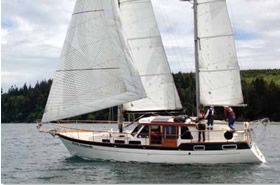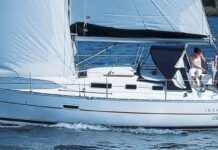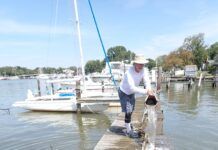Photo courtesy of Giff JonesPhotos courtesy of Franklin KasminPhotos courtesy of Bruce WasilewskiPhotos courtesy of R.C. Collins

Great article on navigation software for Macintosh computers (PS, July 2013). I have been having so much difficulty getting a GPS signal into my GPSNavX (via Keyspan HS19) that I rejoiced to read about OpenCPN.
But when I tried to download it, I ran into a few problems: 1. Theres nothing to tell you which version to download for non-Intel Macs (OS 10.4.11); 2. After spending two hours on this project, I ended being unable to contact anyone (even via email) at the company to ask for advice. I finally found a remote item under FAQs that confirmed all: Using OS 10.4.11 on my old-dinosaur Mac PowerBook G4 doesn’t cut it with OpenCPN.
It may be time for an upgrade. I have stuck with my old G4 because I can run it directly on my 12-volt system. Can you recommend a newer Mac laptop that will still run on 12-volt power? And are 12-volt power supplies available? I am loathe-for old-fashioned reasons-to dedicate a separate inverter just for the laptop.
Giff Jones
Havis Amanda, 1984 Nauticat 38
Lake Union, Seattle
We suggest checking with a Mac/Apple vendor, but there seem to be many options for an auto-adapter that can match the output voltage required for Macbook Pro or other Mac laptops. Typically designed for charging a device via a cars cigarette-lighter socket, the adapters use 12-volt power and outputs range from 45 watts to 85 watts. This is a pretty straightforward process, so we imagine youll have a few options. Weve not yet tested these adapters, but www.macbookadapter.com seems to have a varied selection.
Another option would be to use a pocket inverter like those made by Duracell. This may be a safer method, but itll also be slightly less efficient.
In regard to your October 2013 article on smart controls for galley fridges: I bought a Chaney wireless digital thermometer ($30 on Amazon.com) that has alarms and allows you to monitor inside fridge and freezer temperatures without opening the lid. It works well, and you can even rely on it to monitor icing, which affects compressor efficiency. It runs on lithium batteries.
When we have an electrical source-shore power, generator, motor-we turn on the fridge from the control panel. When sailing, we can turn fridge off if the temperature readings are correct. This is very helpful in the hot summer in the Med.
Denis Foster
Hibernia, 2007 Beneteau 43
Bay of Rosas, Catalonia, Spain
In reference to the Mailport letter VHF Batteries in the October 2013 issue: I too have a Uniden MHS350 handheld VHF. I have had the batteries rebuilt at the local Batteries Plus store (www.batteriesplus.com). They replace the cells with higher MAH batteries and will rebuild almost any rechargeable battery with higher capacities, at competitive prices. I have also had them rebuild my 19.2-volt Craftsman drill batteries as well.
Dave Stephan
Bonnie Claire, Chrysler 22
South Patrick Shores, Fla.
Photo courtesy of Giff JonesPhotos courtesy of Franklin KasminPhotos courtesy of Bruce WasilewskiPhotos courtesy of R.C. Collins

I disagree with your suggestion in the October 2013 PS Advisor that occasional chlorine treatments in aluminum water tanks are harmless. We treated the aluminum tanks in our 1990 Caliber 38 soon after we bought her in 1999 because the water smelled and tasted bad. We discovered over the years a tremendous accumulation of white sand-presumably an aluminum chloride salt-that took years to clear through repeated tank cleanings and filtration. I wouldnt risk using bleach in aluminum tanks again.
We finally cured our stinky-water problem two years ago while in the Bahamas by installing a watermaker. Those same tanks, when filled with really clean water, now gush forth with odorless and sweet-tasting water, even after sitting all summer in the Abacos!
Franklin and Esther Kasmin
Estica, 1990 Caliber 38
Mamaroneck, N.Y.
Photo courtesy of Giff JonesPhotos courtesy of Franklin KasminPhotos courtesy of Bruce WasilewskiPhotos courtesy of R.C. Collins

In response to your boat review of the Freedom 36 (PS, June 2000): I have owned a Freedom 36 for the last 23 years and still would not trade it for anything else I have seen on the market in the 36- to 43-foot range. I often sail single-handed, and the boat lends itself well to short-handed sailing. All lines (halyards, reeling lines, vang, sheets) terminate at line stoppers/winches on the cabintop at the cockpit. The boat has a huge main and needs a power winch to handle it more easily.
I have sailed the boat extensively in the Great Lakes, and I can attest that it handles very rough weather reasonably well. After 22 years of admirable service, I had the stern lengthened by nearly 2 feet, adding a sugar scoop, and painted the hull. I also spruced up the interior with a V-berth mattress, new headliner, and new interior cushions, and I finally upgraded all electronics. The boat is now ready for the next 23 years. Tillotson-Pearson did a great job on the Freedom line, and my boat is a testimony to that.
Bruce Wasilewski
Cinereous, Freedom 36
Lake Charlevoix, Mich.
We have used the Streamlight Waypoint Alkaline spotlight for a while, and it is great, as the September 2013 article suggests. It can be used with a 12-volt power cord, in case batteries are not around. Can the new Rechargeable Waypoint (PSs Best Choice cordless LED spotlight) be used with a power cord, or is the cord just to recharge? If the latter is the case, I think the top pick should go to the Alkaline Waypoint due to power options.
Either way, it’s splitting hairs, but what I don’t like about rechargeable spotlights is that you never really know the state of the battery or when to recharge them, and then theres the replacement cost when the battery can’t hold a decent charge. With regular alkaline batteries, you can keep extras on board, they take moments to change, and its cheaper to replace a few batteries than to buy a new rechargeable battery out of warranty. Also, with replaceable alkalines, you get instant full power again, cheaply and quickly.
Paul Seeberg
Via www.practical-sailor.com
The new Waypoint Rechargeable does not have a 12-volt power cord, only a charger cord. Testers found it to be a better all-around spotlight, but we know many people prefer having the power cord and/or replaceable battery options-it comes down to preference-and thats why we rated the alkaline Waypoint as a Recommended spotlight for those seeking a power cord/alkaline option. The Budget Buy West Marine 337 and the Coleman also use replaceable alkaline batteries.
In regard to the PS blog post (May 21, 2013) on prolonging the life of your alternator: I have a few more suggestions for getting the most from your alternator installations.
1. Practice good battery management. Charging in bulk takes a toll on alternators, and the larger a bank gets in relation to the alternator, the longer the alternator is in bulk mode and running hot. It is very easy for a non temp-compensated alternator to exceed 230 degrees in an engine space when driving a large load. Dont regularly discharge below 50-percent state of charge, and try to size your alternator, when hot, to a minimum of 20 percent of bank capacity. With AGM or gel batteries, youll want more alternator capacity.
2. Clean pulley grooves of all rust at the beginning of each season. Rusty pulleys eat belts.
3. When changing alternators, beware of the pivot bolts. Improperly sized bolts can lead to misalignment issues and alternator foot/feet damage.
4. Use a longer adjustment-arm tension bolt, and back it up with a nut and lock washer. These tend to come loose over time. Loose tension bolts are a leading cause of belt slipping.
5. When upgrading the alternator, consider going up a size or two beyond where you have decided you need. If youre using a Balmar external regulator, you can limit the alternator in belt manager to the current handling capability of your belt. De-rating the alternator via the belt manager allows your alternator to run cooler and last longer. It also allows for a future serpentine-pulley upgrade.
6. Also when upgrading, be aware that many large alternators ship with half-inch pulleys and many small auxiliary engines use 3/8-inch belts. Using mis-sized belts will reduce belt life.
7. Know what your belt can safely handle. I find 70 to 80 amps is about max for a 3/8-inch belt and 90 to 100 amps for a half-inch belt. To drive more than that requires a serpentine type belt or a dual-pulley setup.
8. When driving large banks, it is often best to choose external regulation and take advantage of an alternator temperature sensor to prevent the alternator from cooking itself.
9. Pay attention to belt wrap around the crank and alternator pulley. The more wrap, the more horsepower you can drive. If you have minimal wrap and a large bank, consider a pulley upgrade. Machined pulleys seem to do better with heat and driving large loads than do the cheap stamped steel pulleys on many factory alternators.
10. Think of your alternator and battery bank as a team. Neither one can carry all the weight.
R.C. Collins
Compass Marine Inc.
Cumberland Foreside, Maine
Photo courtesy of Giff JonesPhotos courtesy of Franklin KasminPhotos courtesy of Bruce WasilewskiPhotos courtesy of R.C. Collins

When you tested the Garmin Quatix sailing watch (PS, August 2013), how was your test of course over ground (COG) readings? I am asking because my Quatix gives COG +/- 5 degrees, even when walking on a straight line. Compared to my boats electronic compass and GPS, the Quatix is having trouble showing a damped output. Using the Tack Assist or Virtual Start-line is impossible because the output is jumping up and down.
Sten Lembo
Juno, Scan-kap 99
Marselisborg Havn, Denmark
We have been using the watch for months without any issues, but we do have some suggestions for you. The first is to check that WAAS (Wide Area Augmentation System) is enabled. This is not a default setting, because it uses a little more battery power. Selecting this option will enable the use of EGNOS (European Geostationary Navigation Overlay Service), improving the accuracy of the GPS fix. A good EGNOS fix can have an accuracy of +/- 6 feet or better. The other suggestion is to recalibrate the compass. Doing these two steps should resolve your issue. Garmin also suggests that when the GPS is first turned on, keep the watch stationary for a few minutes to ensure a solid fix.
The Quatix is doing GPS fixes at a 10-Hz rate. Thats 10 times per second. The average person walks at 3.1 mph. That is 273 feet per minute, 4.55 feet per second, or 5.4 inches per GPS fix. Heading is calculated every GPS cycle. Just waving your arm can create a new heading that might be 180 degrees different from the previous heading. Because of this, the COG is an average of the calculated heading data. This smoothing of the data causes all GPS units COG to be slightly behind the curve when the direction of travel is changing. The more steady the direction of travel, the closer the COG reading will be to the compass, if properly calibrated. This is exactly the same issue boat owners have. Its typically close, but not perfect. Also, keep in mind that the Quatix compass, like all compasses, is affected by ferrous metals and magnets.
Editors note: Early versions of the Quatix were voluntarily recalled after one report of a hot-battery safety issue. This problem has been corrected in current Quatix stocks. Read more about the recall on the Garmin website, www.garmin.com.
I do not think the genoa sheet lead control systems in the September 2013 issue will work on our Bristol 38.8. Our tracks arc to follow the cabin sides. Does any manufacturer have tracks that could be installed in an arc? Would this application require lead cars to match the arcs?
Bob Forward
Sea Skimmer, 1989 Bristol 38.8, #68
Ottawa, Ontario
You actually have several options. We suggest talking with a few deck hardware makers about their offerings; youll need to contact them with specifics (track length, curve radius, etc.).
Some manufacturers like Seldn (www.seldenmast.com) will work with you to develop a custom bent track, and depending on its arc radius and orientation, you may even be able to find a local machine shop that will bend a track for you based on a tracing of the existing track.
Italian sailing-hardware maker Antal offers custom pre-bent tracks of any type and also machines custom cars for most existing tracks, matching the radius of the already-installed track. If you decide to get lead cars for your existing tracks, keep in mind that a car running on a bent track will have a reduced working load; shorter cars will perform better than long ones. Adding composite-fiber inserts to the car will improve adjustment under load, but it will never match the performance of ball-bearing cars, according to Euro Marine Trading (401/849-0060, www.euromarinetrading.com), Antals U.S. distributor.
In regard to your blog on crotch straps: Makers should build a better PFD, attached to step-in drawers. These would resemble a ballet leotard and be below the PFD buoyancy chambers. Also, marine supply stores should offer loaner PFDs for sailors to test in controlled water-immersion pools. Most sailors have never worn a PFD in deep water. Feeling that jacket trying to slip over your head would encourage rapid innovation.
Edwin Rudetsky
Gloria, 1983 Catalina 30
Shelter Island, San Diego, Calif.






































